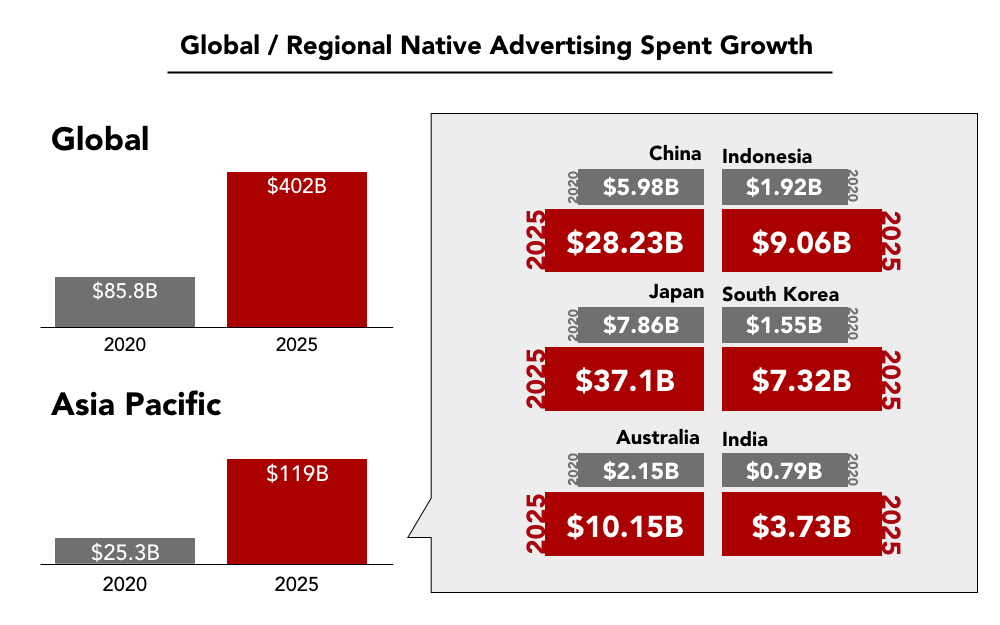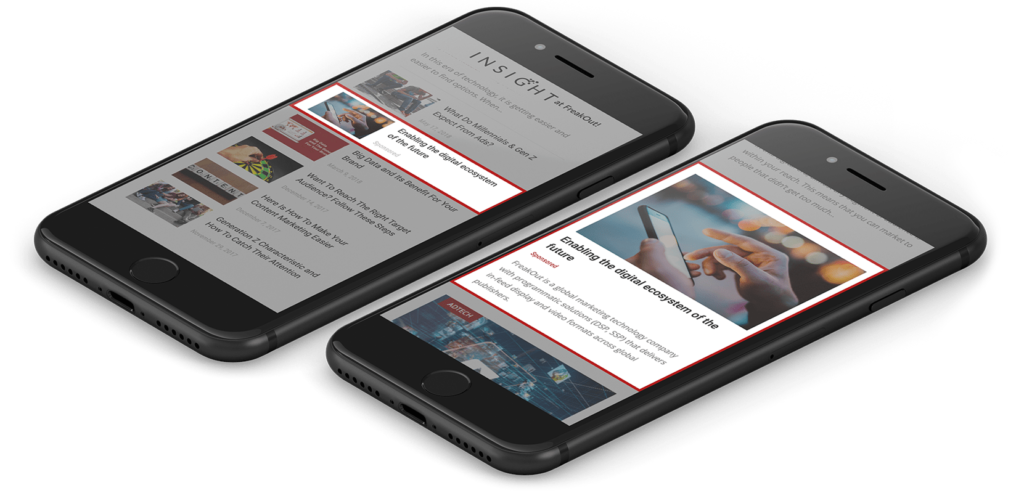Native is the standard ad format for mobile and keeps growing year by year. According to research by ADYOULIKE, native ad spend is expected to increase by 372% from 2020 to 2025. This represents an increase in the native advertising market from $85.83 Billion in 2020 to a total global value of $402 Billion by 2025. In the Asia Pacific, the market will grow from $25.3Billion to $119Billion by 2025.

Compared to 2016, when FreakOut started its native advertising platform business in Asia, the native advertising sales have increased significantly and the awareness has also risen in recent years.
Moreover, the buying methods have changed from traditional reservation ad and ad network to programmatic. Also, formats have become more varied. Not limited to static images, but also videos and rich & interactive creatives are used for native ads today.
In this article, we’ll take a look at 6 of the latest native ads trends that marketers should keep an eye on for the year 2021.
Contents
Native Advertising Trends in 2021

1. More programmatic
For a long time, differences in design and layout of native ads caused by the different size of images and length of titles between mediums, had made it difficult to realise programmatic buying of native ads. Finally, it was around 2019 and 2020 when the largest native ad players and large DSP players connected via RTB.
Meanwhile, in the US, nearly 90% of native ads have already been purchased programmatically. That trend will accelerate in 2021 in Asia as well. In fact, more of our brand advertisers have started to buy native ads programmatically, ever since FreakOut Native got connected with The TradeDesk in 2019.
【Press Release】FreakOut Native Integrates With The Trade Desk
eMarketer forecasted that native advertising will be more programmatic and mobile, but less social. Report said 88.8% of native ads in the US will become more mobile, up from 85.2% in 2018. On the other hand, the share of native that come from social will slightly decline from 76.7% in 2018 to 73.5% in 2020. With this trend, the non-social native ad technology players will benefit the most.
3. Native Video
Video is one of the hottest trends in the digital marketing industry. Nowadays, we’re seeing more and more native video advertising on news feeds and social media feeds.
According to the forecast by eMarketer, native video ad spending is increasing year by year, and it would make up 31.2% of the US native ad spending in 2020.

4. Interactive format
GO-Gulf reported 93% of marketers agreed that interactive content is effective in educating its buyers, and 88% of them said that interactive content is effective in differentiating their brand from their competitors.
Until recently, native ads were simply a set of static images and headlines, but lately the formats with interactive features have emerged.
FreakOut also launched new interactive native ad formats last year.
Native Search is the solution for clients having online shopping functions. It has a keyword search window in native ad. When users input keywords and click the search button, they will be led to the search result page on advertisers’ shopping sites.

5. Valuable contents are expected
Native advertising is favourably received by audiences, and they expect native ads to provide them with valuable information.
According to a survey by Time Inc, close to 90% of younger internet audience from Gen Z, millennials and Gen X prefer custom content including native ads online instead of traditional ads. About 93% of the audience said that they prefer brands that put some effort in creating something unique to get their attention. Over 56% of the audience said they like brands sharing something with value rather than just trying to sell something.
So, landing pages which users will be led after clicking native ads should be the contents which provide valuable information about your product/service and explain how it helps the audience.
6. Context marketing and storytelling
The placement where users see your ads is also an important aspect which should be put into consideration.
As mentioned earlier, the share of social native ads is slightly declining, and it seems that more advertisers are putting priority on context and find it effective to place native ads on premium media.
According to the report by Outbrain, advertising shown on premium news sites are much more likely to be trusted (+44%), clicked on (+21%) and lead to future purchases (+24%) than advertising shown on social media platforms.
The research by AOP also shows that native ads garner greater levels of trust among consumers with 33% more likely to trust native ads than traditional advertising, and that clicking on a native ad on a premium website has greater impact than clicking via Facebook.
This trend also applies to the landing pages of native ad campaigns.In the last couple of years, we have received more requests from advertisers who want to buy a set of native ads and sponsored contents in premium media. Sponsored contents in premium media give more credibility to your products/service. At the same time, the article produced by professionals can entertain audiences.
Conclusions
As we have seen, native advertising has evolved considerably over the years and there are a wider range of buying methods, formats and ways to use it.
The key for the success of native advertising campaign is having the mindset to create valuable content and deliver it to your target audience in the right place and in the right way.
FreakOut has been offering native ads in 11 Asian countries since 2016. We would be delighted to help you with your native advertising campaign!

Let’s start your native advertising campaign with FreakOut!
For more information (rate card, quotation, case study etc..), please contact us with the following buttons. Local team will support you as soon as we can.
▼Reference List
- 8 Native Advertising Statistics That Will Convert You
- In 2020, Native Advertising will be More Programmatic and Mobile – but Less Social
- Advertisers Spend More on Native, but Favor the Same Formats
- Breaking Out Video Ads: Native vs. In-Stream
- The State of Interactive Content Marketing – Statistics and Trends
- The Power of Native Consumer Research Study by Outbrain & Lumen
- AOP releases The Power of Native research report
▼Other articles on Native Advertising




